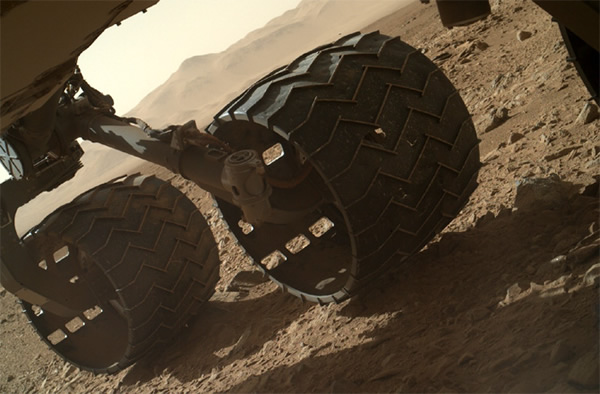Curiosity Back to Dominating Mars After Hiccup
NASA's Mars rover Curiosity used its robotic arm-mounted Mars Hand Lens Imager (MAHLI) to capture views of its wheels on Nov. 24, 2013, after 6 days of inactivity due to an electrical "soft short." Note the punctures and holes in the rover's aluminum wheels -- the material was designed to sustain such damage after 463 sols (days) roving the Red Planet's surface..
It's hard being a robot exploring another world, as NASA's Mars Science Laboratory has proven this month.
On Nov. 17, mission managers of the six-wheeled rover Curiosity announced that they were troubleshooting a suspected "soft short" in the robot's electrical system. A soft short is a glitch where a small amount of power is leached through a material that's partially conductive.
Curiosity's electronics are built with this eventuality in mind, so mission engineers weren't overly alarmed. However, the resulting voltage drop from the rover's chassis and power bus was cause for concern and could have affected the mission's robustness against more soft shorts in the future.
But on Nov. 25, NASA Jet Propulsion Laboratory (JPL) scientists announced that Curiosity was back to science operations after a precautionary six-day suspension and its power supply was back to pre-Nov. 17 levels.
Engineers had traced the soft short to the rover's Multi-Mission Radioisotope Thermoelectric Generator -- the mission's power source that harnesses the heat generated by pellets of radioactive plutonium-238 and turns it into electricity.
"We made a list of potential causes, and then determined which we could cross off the list, one by one," said Rob Zimmerman, rover electrical engineer at JPL in Pasadena, Calif., in a news release.
The return to normal levels of power after the soft short is consistent with shorts experienced by other spacecraft that use radioisotope thermoelectric generators (RTGs) for power. The NASA Cassini Saturn orbiter, for example, has experienced soft shorts, all of which have been troubleshooted, returning power to normal levels.
One of the first signs that Curiosity was back hard at work after the short hiatus was the new raw imagery uploaded to the JPL archive. Curiosity's robotic arm-mounted Mars Hand Lens Imager (MAHLI) was even used to check out the rover's undercarriage, including its six 20-inch aircraft-grade aluminum wheels.
As reported by Discovery News in May, Curiosity's wheels are showing obvious signs of wear and tear -- now including a rather dramatic hole in the thin material between a left-hand wheel's tread (see photo, top). These points of damage may looks serious, but it's all part of Curiosity's design.
"The wear in the wheels is expected," Matt Heverly, lead rover driver for Curiosity, told Discovery News on May 22. "The 'skin' of the wheel is only 0.75mm thick and we expect dents, dings, and even a few holes due to the wheels interacting with the rocks."
Aside from firing up its awesome array of cameras once more, Curiosity also delivered powdered rock from drilling operations to its onboard chemistry laboratory over the weekend, the first time since it analyzed samples from "Cumberland" rock six months ago.
Analysis of these new samples has already begun and planetary scientists are expecting a bountiful array of data that will further reveal Mars' geological history and potential habitability.
Curiosity landed inside Gale Crater on Aug. 6, 2012, and is currently roving toward a 5.5 kilometer high rise, Aeolis Mons (or "Mount Sharp") in the center of the crater's plain, Aeolis Palus. Along the way, however, the rover is stopping at geologically interesting points to continue to unravel the Red Planet's mysterious past.(Nov 25, 2013 10:41 PM ET // by Ian O'Neill)












